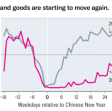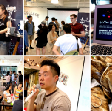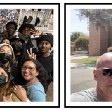Physical and digital collide: what’s next for retail?
In an industry that’s heavily reliant on bricks and mortar , fashion was impacted by the pandemic on every single level; production stopped, stores shut, and demand decreased. At its height, Britain lost more than 17,500 chain stores. This led to changes in how and where people shopped — online shopping boomed, home improvements went through the roof and more people shopped locally.
There’s no doubt it had a major impact on the industry — let’s not kid ourselves — there were issues before C-19 arrived and we’re still in a really hard post-pandemic recovery period. Trading conditions continue to be tough. We’re still seeing big-name businesses disappearing from the high street or going under completely. Socio-economic conditions are impacting the industry: a war in Ukraine, cost of living crisis impacting consumer trends, an uncertain supply chain and consumer habits demanding more and more from brands.
At Magnetic we recently worked with a well-known retailer to look at the ideal relationship between physical and digital worlds. We know the boundary between them is becoming more and more permeable, creating interesting implications as we design and build new spaces. Having been out in stores and high streets talking to shoppers about new habits and immersing in the world of retail, here are the trends affecting the retail sector:
Tightening our belts
The cost of living crisis continues to deepen and everybody is talking about it. Money saving tips and tricks are being swapped in cafes, work corridors, over Zoom and all across social media — between family, friends, and strangers alike. Coupled with concerns around inflation and consumer spending and the current economic environment is hitting the retail industry hard:
‘Sales volumes are falling to a rate not seen since the depths of the pandemic, as inflation continues to bite, and households cut back spending.’ Helen Dickinson OBE, Chief Executive, BRC
There’s no wonder then that consumers are being cautious with where and what they spend money. Retailers are walking a tightrope between rising business costs, small margins and further protecting consumers against price increases, while negotiating with suppliers to share cost increases:
According to a BRC article: “Cost and efficiency will dominate retailers’ agendas as they are forced to make some tough decisions on which products make it to the shelves in order to remain price competitive for consumers.”
There are green shoots. The factors driving prices up are (fingers crossed) short term. The only thing we know for certain right now: retailers need to give a strong reason for consumers to buy.
Keep it loyal
“At a time when consumer behaviours are changing fast, customer experience is more important than ever, so brands will have to work harder to emotionally engage with consumers and retain loyalty,” Kyle Monk, director of Insight at the British Retail Consortium (BRC).
Loyalty programs have always proved an effective approach for increasing sales and acquiring customer loyalty. It’s hard to leave most stores without a ‘do you have a Club card *or insert alternative loyalty card*? It’s a great way to get data on consumers and target advertising and sales based on what matters to them. It means most retailers today are hunting to find innovative ways to create rewards programs and build customer loyalty.
In the current climate loyalty will become the new frontier for growth. From reputation management to tapping into sustainable options or a growing desire to shop local (something that’s stuck since the pandemic). We’re also likely to see more flexibility when it comes to managing finances and more choice when it comes to payment options like buy now pay later.
Loyalty is not all about cards either. Brands must build a deep understanding of customers’ motivations to help place bets on which products and services to invest in to sustain a competitive edge. You build better products and services when you get close to and empathise with the people you’re designing for. This is even more important in order to keep up with changing consumer needs and behaviours in a post pandemic world. There’s never been a bigger need for user research. Take a look at our recent article on some techniques that have worked for us.
The Conscious Consumer
The new breed of consumer is conscious, conscientious and knowledgeable when it comes to purchasing products. People care about where the products are made, the material, packaging and the impact on the environment. Retailers know they need to put sustainability at the heart of their business, buying decisions and across the entire supply chain.
The onus on brands and retailers in 2022 and beyond is walking the walk. It’s not enough to just talk about green credentials, they must convince consumers that their efforts are genuine. It’s not just about being green either. Conscious consumerism is reshaping consumer behaviour on a number of levels. From environmental concerns to better representation in the products that are sold and the models and advertising that’s selling them — the now and future consumer expects more and expects better.
Resale and the circular economy will play a big role in minimising the environmental impact of the retail industry. Retailers are trying to leverage this trend:
- Luxury online platform Farfetch has partnered up with on-demand donation service Thrift+ in a bid to encourage shoppers to donate their pre-loved items and support circular fashion. Customers give back and get FarFetched credit in return.
- This year, ITV show Love Island announced a new partnership with eBay UK. They used the partnership with the online marketplace to show the benefits of pre-loved clothing and to change the way we think about and shop for clothes.
- Etsy’s purchase of Depop, the British secondhand fashion resale app, for $1.6bn (£1.1bn) to tap into the fast-growing trend of generation Z young people reselling clothes online.
- Lithuania based online marketplace Vinted is now Europe’s largest C2C marketplace now used by 45m consumers and estimated to be worth $4.5bn.
Still dominated by clothes, the resale trend will no doubt show huge growth this year and likely other areas will follow suit. We’ll likely see more platforms pop up and a move into other areas such as homeware or electronics.
Shopping going hybrid
The mix of surging digital commerce, the pandemic’s impact and general rise in hybrid living has forced the high street to rethink the physical and online. This isn’t new. Retailers have been gaining a more sophisticated view of the customer buying journey both on and off line for some time. This has highlighted the need for hybrid retail — and it’s being adopted by large and small businesses alike.
Retailers are starting to build on the unique in-person strengths you get from being in-person at a physical shop, while utilising the opportunities offered by tech. Enter the hybrid high street: an experience that gives consumers the choice and convenience of the digital world with the excitement, humanity and immediacy of a store.
From virtual styling, to scan-as-you-shop to online buying and in store pick ups. Brands are thinking about or already adopting a pragmatic, inclusive approach and that means utilising, adopting, and experimenting with omni channels.
Towards the end of 2021, a Nike and Roblox partnership announced an immersive virtual experience, called Nikeland, a Nike store in the metaverse. Billed as one of the biggest, and most grounding metaverse retail announcements. Nikeland allows players to dress their avatar in Nike gear and play in a virtual world where there are no rules.
The creation of the metaverse could allow retail brands to step away from what is known: giving brands access to another channel away from brick and mortar stores. Although in its infancy, there are millions of people that log into the metaverse daily, demonstrating a potential ripe revenue stream ready to be tapped into. 4 months after its launch, a total of 6.7 million players from 224 countries visited Nikeland, showing its reach and attraction in the sports retail space. It begs the question: will other areas of retail be able to seize the opportunities that the immersive experience of the Metaverse offers, and make it relevant to their customers?
Hybrid retail simply makes sense — it’s the new way to save the British high street and look at online vs offline as a partnership rather than separate things. The difficult part is getting it right and focussing on the tech and customer journey to make sure it’s delivered seamlessly and the experience is easy and slick for customers.
Magnetic is a design and innovation company that helps design better futures. We’ve worked with global businesses to build capabilities, products, services and transform organisations. If you’d like to find out more about our work, get in touch with Lucy Willett or drop us a line.
Authors: Tomer Tricot & Lucy Willett






